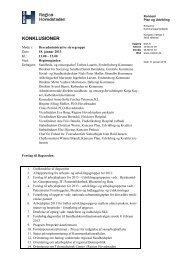Territorial Review Copenhagen - Region Hovedstaden
Territorial Review Copenhagen - Region Hovedstaden
Territorial Review Copenhagen - Region Hovedstaden
You also want an ePaper? Increase the reach of your titles
YUMPU automatically turns print PDFs into web optimized ePapers that Google loves.
252<br />
growth. Similar findings were found in a study of 24 cities in the United<br />
States over 1977-1992 (Kresl and Singh, 1999): the number of research<br />
centres per million workforce was correlated with the growth of retail sales,<br />
manufacturing value added and business service receipts. University R&D<br />
also has an effect on new firm formation: Kirchhoff finds that it has the third<br />
most significant effect after market size and population size (Kirchhoff,<br />
2007). Goldstein and Renault (2004) studied 312 Metropolitan Statistical<br />
Areas in the United States over 1969-1998 using a quasi-experimental<br />
approach in which the measure of regional economic development was<br />
workers‘ average annual earnings. They found that research and technology<br />
functions generate significant knowledge spilovers that result in enhanced<br />
economic development that would otherwise not have occurred. In the<br />
period 1986-1998, total university R&D activity was significantly related to<br />
regional economic growth. The strength of the causal relationship is<br />
however modest. Controlling for other factors, it would have taken an<br />
increase of USD 10 million in research expenditures among universities in<br />
an average metropolitan statistical area to increase the index of average<br />
earnings per job by 0.36%.<br />
There are minimum thresholds for R&D and technology. For R&D<br />
investment to be effective, a minimum threshold of investment is necessary.<br />
The relationship between R&D and economic development is not linear.<br />
Furthermore, there are externalities associated with R&D, and returns from<br />
R&D rely heavily on the quality of the workforce and the quality of the local<br />
human capital (Rodriguez-Pose and Crescenzi, 2008).<br />
Universities have a potential role to act as a node in knowledge<br />
networks linking regions and their actors to regional and international<br />
knowledge sources. There is however considerable variability in the<br />
capability of universities to effectively transfer their knowledge; and of<br />
regional businesses to effectively absorb such knowledge. Policy has sought<br />
to establish intermediary brokers and intermediary institutions. In some<br />
regions, such efforts appear to be bearing fruit through acknowledged<br />
contributions to regional development. However, it is not always the case,<br />
which makes it difficult to ascribe improved regional competitiveness to<br />
developments in knowledge-based infrastructure (Huggins et al., 2008).<br />
In these constellations, knowledge institutes will not always be willing,<br />
or in a position, to transfer knowledge across networks, if there is a low<br />
expectancy of reciprocal return. Universities are often wary of engaging<br />
with a business community dominated by SMEs, which they often regard as<br />
inferior and less lucrative collaborators and partners in comparison to larger<br />
and more internationally focused firms. Effective knowledge absorption is<br />
more likely to occur through collaborative networks than it is through<br />
market transactions. Perkmann and Walsh (2007) find that research

















